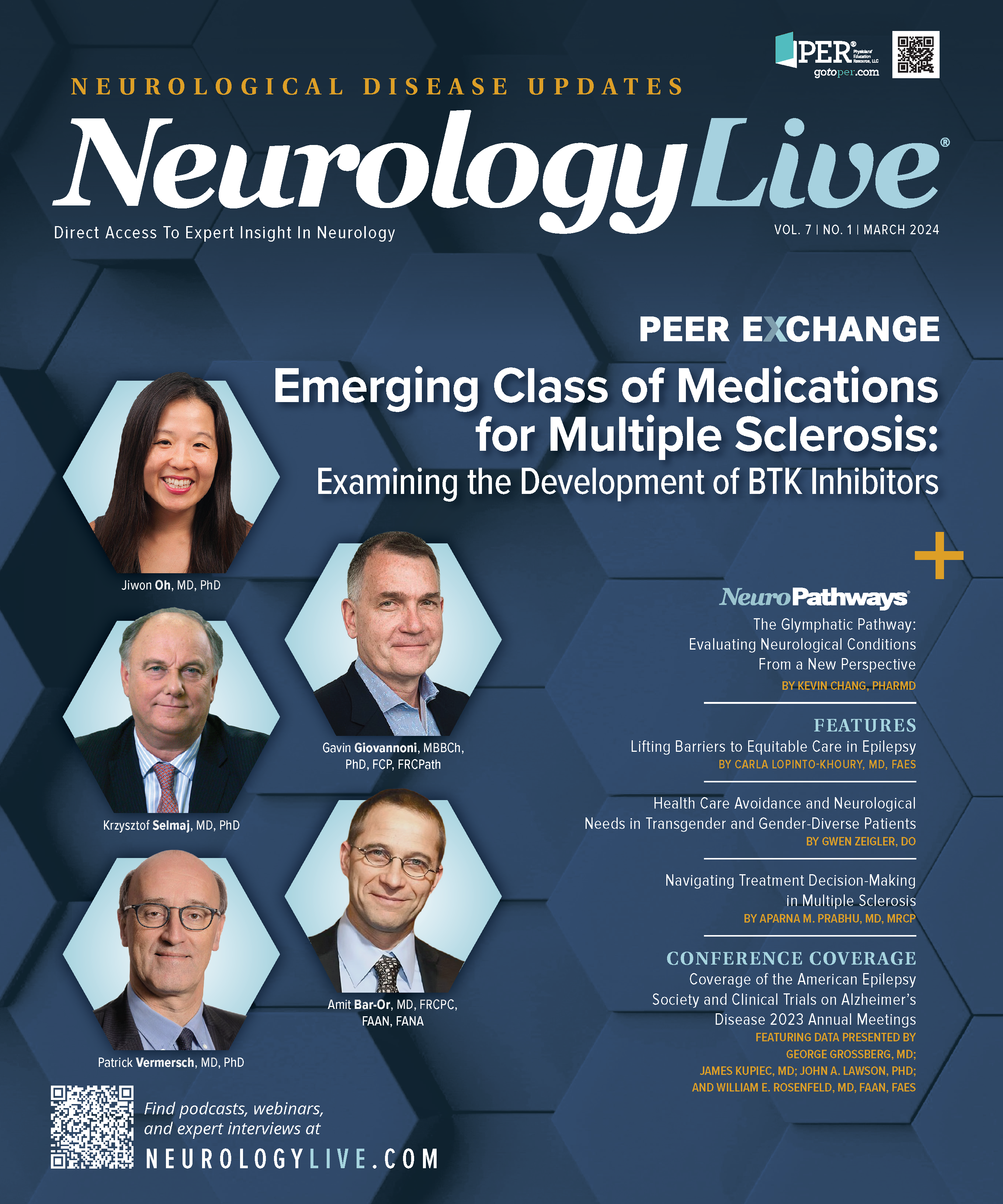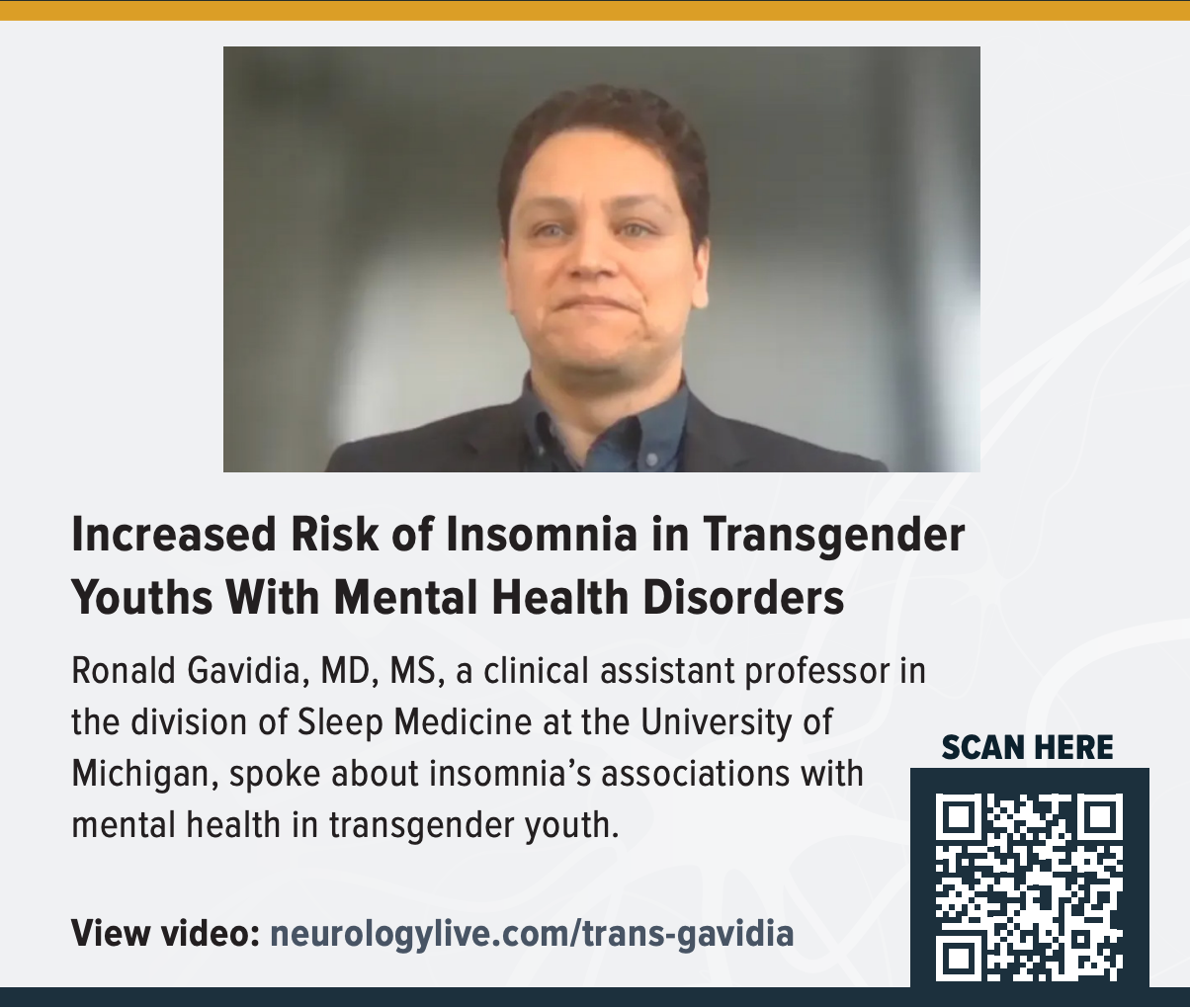Health Care Avoidance and Neurological Needs in Transgender and Gender-Diverse Patients
Transgender and gender-diverse patients have unique neurological considerations, but often, neurologists are unaware of the needs that are specific to this community.
Gwen Zeigler, DO

NEUROLOGISTS CAN INFLUENCE the likelihood of future health care avoidance in some transgender and gender-diverse patients through affirming environments with structural competence and cultural humility.1-4 These patients also have unique neurological considerations. Unfortunately, many neurologists are unaware of the needs that are specific to this community.5
The occurrence of medical avoidance among transgender and gender-diverse people has been established in several studies.1-3 For example, the 2015 US Transgender Survey found that approximately 23% of respondents reported avoiding health care out of concern for being mistreated as a transgender person.3 Additionally, 33% of respondents had a negative experience with a health care provider related to them being transgender in the prior year, and 24% had the negative experience of having to educate their health care provider about their care.3
Fear of discrimination has been shown to lead to health care avoidance in transgender and gender-diverse people in the United States and South Korea.1-3 Poverty, a social determinant of health, and visual nonconformity have also been shown to increase the risk of health care avoidance. Conversely, disclosure of gender identity has been shown to be protective against this.1 To reduce medical avoidance, clinical environments may advertise themselves as safe to make transgender and gender-diverse patients feel more comfortable utilizing their services. However, this may not foster future trust if these environments have patients who have a negative experience related to being transgender or gender diverse. This is why structural competency and cultural humility with this community are essential. An association has also been found between improved mental health outcomes among transgender and gender-diverse patients and having experienced a health care provider who treats these same patients with respect.4
Understanding Terminology
At the very minimum, neurologists should understand the difference between sex, gender, and sexuality.6 Understanding terminology is important and must be accompanied by cultural humility and a willingness to adjust to each individual patient’s terminology, vocabulary, and pronouns. Like the rest of the LGBTQIA+ community, the transgender and gender-diverse community is varied, and these individuals have different experiences and cultures related to terminologies across sex, gender, and sexuality.7
One concern many providers may have is the potential of accidentally misgendering transgender and gender-diverse patients. Avoiding forms of identity invalidation, such as misgendering, is critical. In fact, one study that measured predictors of psychological distress in transgender and gender-diverse patients from the distal minority stressors of family rejection, threat of harm, and identity invalidation found identity invalidation to be the most impactful and most significantly associated with distress.8 We have learned to associate so many characteristics with gender that our minds habitually assign a gender to people who may not match that person’s actual gender. As a result, the cognitive process (known as automaticity) can cause a clinician to unintentionally misgender a person.9 One way to reduce the likelihood of this error, and possibly change these mental assumptions and verbal habits, can be through practicing the use of gender-neutral language.10 If you do make a mistake, the best practice is to apologize once, move on, and do better.6
Alignment With Care and Treatments
A 2019 survey study by Rosendale et al of 1000 American Academy of Neurology members (with 135 respondents) found that although most respondents felt comfortable assessing LGBTQAI+ patients, 43% believed that sexual orientation and gender identity did not have any bearing on neurological management.5 This lack of awareness can lead to suboptimal outcomes in our management of these patients. A survey of 177 Italian neurologists in 2023 found that only 2.8% (n = 5) of these neurologists received adequate clinical training and supervision to work with transgender and gender-diverse patients, but that 86.4% (n = 154) of these neurologists were interested in receiving further training on culturally appropriate care for LGBTQAI+ patients.11 A study from Boston University School of Medicine found that deliberately teaching medical students LGBTQAI+ terminology and concepts during preclerkship years correlated to greater recall of being taught about these subjects. This study emphasizes the importance of being deliberate and intentional in educating about LGBTQAI+ concepts.12
Neurologists must be aware of how gender-affirming hormone therapy can affect neurological conditions.13-15 For example, research from cisgender women has shown that estrogen can have proconvulsive properties in some individuals.15 Communicating this risk to a transfeminine patient with epilepsy who has not started estrogen is important. It is also important to be aware of when a patient with epilepsy may start estrogen to consider whether any adjustments to antiseizure medication should be taken, either because of an increased risk of seizure from the estrogen or a potential interaction of the antiseizure medication with the estrogen.16 Conversely, research from cisgender women found that natural progesterone can have anticonvulsive properties in some,14 but medroxyprogesterone does not have this anticonvulsive protection.17 Neurologists should also be aware of interactions between antiseizure or headache medications and gender-affirming hormone therapies, such as with zolmitriptan and estrogen.18 Neurologists also need to be aware of potential interactions between neurological medications and HIV therapies.19
Trans Broken Arm Syndrome
Although it is important to be aware of the potential neurological adverse effects of gender-affirming hormone therapies, it is also important to avoid a bias that is known to the trans and gender-diverse community as trans broken arm syndrome.20 This is a name given for explicit and incorrect misattribution of a medical problem being caused by either someone’s gender identity or their gender-affirming therapy, or inappropriate or invasive questions about someone’s gender identity or gender transition status.20 Neurologists must be aware of their own implicit biases to reduce this occurrence in their interactions with trans and gender-diverse patients. The bias of trans broken arm syndrome is also seen in publications with case studies, including one attributing testosterone to chronic inflammatory demyelinating polyneuropathy in a transmasculine patient 9 years after starting testosterone, with one suggested mechanism being that the testosterone was high for a “genetic female,” when it was also within the normal male range.21
There is a need to collect information in electronic health records on sexual orientation, gender identity, and sex characteristics.7 From a community-based perspective, it is best to not make answering the questions to collect these data mandatory. A primary reason for this is to not pressure people who do not want to reveal this information and may feel forced to out or misgender themselves. From a clinician viewpoint, gathering this information helps a neurologist better know how to respect and interact with the patient and can help with knowing the best language and terminology that should be used. This information can also help clinicians who cast aside their biases to properly take these factors into account to optimize neurological care. Lastly, collection of these data allow for the transgender and gender-diverse people, as well as the entire LGBTQIA+ population, to be included in studies that use data from electronic health records.7 In 2022, Rioux et al pointed out that because academic language around pregnancy is largely centered toward cisgender women, gender-diverse people who can also get pregnant are not explicitly included in studies with pregnant patients.22 Studies involving pregnant patients with neurological disorders may have gender-diverse patients in them, but if the data on gender identity were never collected or included in the language of the studies, this population of patients can get erased from those studies.22
More research is needed on medical avoidance, the effects of social determinates of health on neurological conditions in this community, and on neurological conditions in general in this same community. Transgender and gender-diverse patients deserve the same quality of care with their unique neurological needs as anyone else. These patients must be explicitly included in research to better understand these needs.
Existing research shows that social stressors, including discrimination and trauma, can have negative effects on neurological health.23,24 In a study of 3325 LGBTQIA+ individuals, 40.9% (n = 876) of whom were trans or gender diverse, an unadjusted analysis of the combination of trauma and discrimination was shown to be associated with higher odds of moderate to severe migraine disability. This association lost significance after adjustment for psychiatric comorbidities.24 Literature has also attributed social stressors to play a role in an increased lack of physical activity in trans and gender-diverse youth, as well as suggested social stressors to have a role in an increased lack of activity in trans and gender-diverse adults and increased tobacco use in the trans and gender-diverse population.23 Structural competency and cultural humility toward trans and gender-diverse patients are critical to the neurological health of this community and can help to increase medical utilization. More research is needed on medical avoidance, the effects of social determinates of health on neurological conditions in this community,23 and on neurological conditions in general in this same community.25 Transgender and gender-diverse patients deserve the same quality of care with their unique neurological needs as anyone else. These patients must be explicitly included in research to better understand these needs.
REFERENCES
1. Kcomt L, Gorey KM, Barrett BJ, McCabe SE. Healthcare avoidance due to anticipated discrimination among transgender people: a call to create trans-affirmative environments. SSM Popul Health. 2020;11:100608. doi:10.1016/j.ssmph.2020.100608
2. Lee H, Operario D, Yi H, Choo S, Kim JH, Kim SS. Does discrimination affect whether transgender people avoid or delay healthcare?: a nationwide cross-sectional survey in South Korea. J Immigr Minor Health. 2022;24(1):170-177. doi:10.1007/s10903-021-01193-9
3. James S, Herman JL, Rankin SR, Keisling M, Mottet L, Anafi M. The report of the 2015 U.S. Transgender Survey. 2016. Accessed February 17, 2023. https://www.semanticscholar.org/paper/ The-Report-of-the-2015-U.S.-Transgender-Survey-James-Herman/e7be734f9129854a0288493 a739b2df1bdfdf06d
4. Kattari SK, Bakko M, Hecht HK, Kattari L. Correlations between healthcare provider interactions and mental health among transgender and nonbinary adults. SSM Popul Health. 2020;10:100525. doi:10.1016/j.ssmph.2019.100525
5. Rosendale N, Ostendorf T, Evans DA, et al. American Academy of Neurology members’ preparedness to treat sexual and gender minorities. Neurology. 2019;93(4):159-166. doi:10.1212/WNL.0000000000007829
6. Lerario MP, Rosendale N, Waugh JL, Turban J, Maschi T. Functional neurological disorder among sexual and gender minority people. Neurol Clin. 2023;41(4):759-781. doi:10.1016/j.ncl.2023.02.010
7. Byer L, Orozco-Poore C, Rosendale N. Limitations and future directions in sex, sexuality, and gender diverse research in neurology. Ann Neurol. Published online December 19, 2023. doi:10.1002/ana.26863
8. Pease M, Williams ND, Iwamoto DK, Salerno JP. Minority stressors and their associations with severe psychological distress among gender-diverse people. Am J Orthopsychiatry. 2022;92(5):578-589. doi:10.1037/ort0000635
9. Robbins TW, Costa RM. Habits. Curr Biol. 2017;27(22):R1200-R1206. doi:10.1016/j.cub.2017.09.060
10. Conte WL, Cascione M, Sullivan AB. Podcast on the challenges and recommendations to address unmet needs in MS for LGBTQ+ populations in the United States. Neurol Ther. 2023;12(5):1399-1407. doi:10.1007/s40120-023-00506-4
11. Nicoletti A, Giuliano L, Donzuso G, Cicero CE; Gender Neurology Study Group of the Italian Society of Neurology. Exploring the knowledge, attitudes, and practices on sexual and gender minorities patients: a survey on Italian neurologists. Neurol Sci. Published online November 10, 2023. doi:10.1007/ s10072-023-07181-1
12. Crosby B, Gell-Levey IM, Monroe J, et al. Comparison of faculty and student perceptions of sexual and gender minority content in a preclerkship medical curriculum. BMC Med Educ. 2023;23(1):973. doi:10.1186/s12909-023-04925-7
13. Aloisi AM, Bachiocco V, Costantino A, et al. Cross-sex hormone administration changes pain in transsexual women and men. Pain. 2007;132(suppl 1):S60-S67. doi:10.1016/j.pain.2007.02.006
14. Bäckström T, Zetterlund B, Blom S, Romano M. Effects of intravenous progesterone infusions on the epileptic discharge frequency in women with partial epilepsy. Acta Neurol Scand. 1984;69(4):240-248. doi:10.1111/j.1600-0404.1984.tb07807.x
15. Logothetis J, Harner R, Morrell F, Torres F. The role of estrogens in catamenial exacerbation of epilepsy. Neurology. 1959;9(5):352-360. doi:10.1212/wnl.9.5.352 16. Sidhu J, Job S, Singh S, Philipson R. The pharmacokinetic and pharmacodynamic consequences of the co-administration of lamotrigine and a combined oral contraceptive in healthy female subjects. Br J Clin Pharmacol. 2006;61(2):191-199. doi:10.1111/j.1365-2125.2005.02539.x
17. Johnson EL, Kaplan PW. Caring for transgender patients with epilepsy. Epilepsia. 2017;58(10):1667- 1672. doi:10.1111/epi.13864
18. Ferrari A, Sternieri E, Ferraris E, Bertolini A. Emerging problems in the pharmacology of migraine: interactions between triptans and drugs for prophylaxis. Pharmacol Res. 2003;48(1):1-9.
19. Hranilovich JA, Millington K. Headache prevalence in transgender and gender diverse youth: a single‐center case-control study. Headache. 2023;63(4):517-522. doi:10.1111/head.14493
20. Wall CSJ, Patev AJ, Benotsch EG. Trans broken arm syndrome: a mixed-methods exploration of gender-related medical misattribution and invasive questioning. Soc Sci Med. 2023;320:115748. doi:10.1016/j.socscimed.2023.115748
21. Taira Y, Omote Y, Kawahara Y, et al. The first case of chronic inflammatory demyelinating polyneuropathy after transsexualism and continuous testosterone administration. Neurol Clin Neurosci. 2021;9(4):346-348. doi:10.1111/ncn3.12514
22. Rioux C, Weedon S, London-Nadeau K, et al. Gender-inclusive writing for epidemiological research on pregnancy. J Epidemiol Community Health. 2022;76(9):823-827. doi:10.1136/jech-2022-219172
23. Streed CG Jr, Beach LB, Caceres BA, et al. Assessing and addressing cardiovascular health in people who are transgender and gender diverse: a scientific statement from the American Heart Association. Circulation. 2021;144(6):e136-e148. doi:10.1161/CIR.0000000000001003
24. Rosendale N, Guterman EL, Obedin-Maliver J, et al. Migraine, migraine disability, trauma, and discrimination in sexual and gender minority individuals. Neurology. 2022;99(14):e1549-e1559. doi:10.1212/WNL.0000000000200941
25. Rosendale N, Wong JO, Flatt JD, Whitaker E. Sexual and gender minority health in neurology: a scoping review. JAMA Neurol. 2021;78(6):747-754. doi:10.1001/jamaneurol.2020.5536

